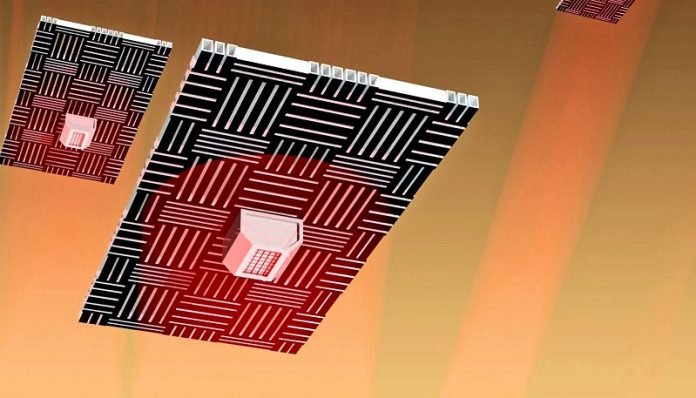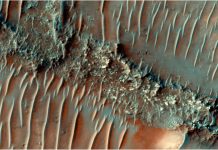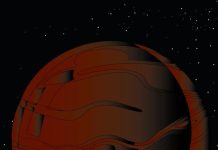
A fleet of tiny “nanocardboard” aircraft could help explore Mars, researchers say.
They each weigh about as much as a fruit fly and have no moving parts.
This summer, NASA plans to launch its next Mars rover, Perseverance, which will carry with it the first aircraft to ever fly on another planet, the Mars Helicopter.
As the first of its kind, the Mars Helicopter will carry no instruments and collect no data—NASA describes merely flying it at all as “high-risk, high-reward” research.
With the risks of extraterrestrial flight in mind, researchers are suggesting a different approach to exploring the skies of other worlds.
Their flyers are plates of nanocardboard, which levitate when bright light hits them.
As one side of the plate heats up, the temperature differential gets air circulating through its hollow structure and shooting out of the corrugated channels that give it its name, thrusting it off the ground.
A new study shows nanocardboard’s flying and payload-carrying abilities in an environment similar to that of Mars.
The thinner atmosphere there would give the flyers a boost, enabling them to carry payloads ten times as massive as they are. The weaker Martian gravity would further enhance their capabilities.
“The Mars Helicopter is very exciting, but it’s still a single, complicated machine,” says Igor Bargatin, assistant professor in the mechanical engineering and applies mechanics department at the University of Pennsylvania.
“If anything goes wrong, your experiment is over, since there’s no way of fixing it. We’re proposing an entirely different approach that doesn’t put all of your eggs in one basket.”
Bargatin’s group has been experimenting and improving on their nanocardboard design since 2017.
Inspired by the common paper packaging material, they collaborated with researchers at the Singh Center for Nanotechnology to achieve a record-setting ratio of weight and stiffness, as reported in a 2018 Nature Communications paper.
Like paper cardboard and other “sandwich structured composites” used in architecture and aviation, nanocardboard’s material properties stem from corrugation.
Consisting of a hollow plate of aluminum oxide walls that are only a few nanometers thick, that corrugation is a regular pattern of channels spanning the plate, which enhance its bending stiffness and prevent cracks from propagating.
The researchers are now using a low-pressure test chamber to study nanocardboard’s ability to levitate when bright light shines on it.
These channels are also responsible for the plates’ ability to levitate, as creating a temperature differential generates an air current that flows through their hollow structure.
“The air current through these micro-channels is caused by a classical phenomenon called ‘thermal creep,’” says Hu, “which is a rarefied gas flow due to the temperature gradient along the channel wall.”
Their recent study allowed the researchers to measure the flyers’ ability to lift mock payloads—silicone rings, attached to the top of the plates—thanks to a new low-pressure test chamber with integrated cameras and light sources.
Studying these dynamics are important for vetting nanocardboard’s potential as a material for atmospheric probes, especially on other worlds, including Mars, Pluto, and Neptune’s moon Triton.
Because Bargatin’s nanocardboard flyers weigh about a third of a milligram, it would take more than a million of them to equal the mass of the Mars Helicopter, and more than six billion to equal the ground-based rover that will deploy it.
But even in the ideal environment of the Martian atmosphere, the tiny flyers would still be limited to sensors and payloads that are at most a few milligrams.
As such, Bargatin is now collaborating with other researchers on how to miniaturize chemical sensors that could detect water or methane—key signatures of life on Mars.
“In addition to carrying sensors,” Bargatin says, “our flyers could simply land and have grains of dust or sand passively stick to them, then transport them back to the rover so it doesn’t need to travel as far.”
The rover could also provide a means of piloting the nanocardboard flyers. Despite having no moving parts, they can be steered by way of a pinpoint laser, since the direction of the air flowing out of their channels depends on which parts of the plate are heated.
Terrestrial applications are also possible. “The Earth’s mesosphere is pretty similar to the Martian atmosphere in terms of density, and we currently don’t have anything that flies there, since it is too low for space satellites but too high for airplanes and balloons,” Bargatin says.
“Ideally, you’d like to have some sensors up there as well. The more knowledge you have about the movement of the atmosphere at that level, the better predictions you can make about Earth’s climate and even weather.”
The research appears in Advanced Materials.



